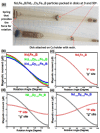Determination of Dy substitution site in Nd2-xDyxFe14B by HAADF-STEM and illustration of magnetic anisotropy of "g" and "f" sites, before and after substitution
- PMID: 33737675
- PMCID: PMC7973419
- DOI: 10.1038/s41598-021-85713-5
Determination of Dy substitution site in Nd2-xDyxFe14B by HAADF-STEM and illustration of magnetic anisotropy of "g" and "f" sites, before and after substitution
Abstract
Nd2Fe14B and Nd2-xDyxFe14B (x = 0.25, 0.50) particles were prepared by the modified co-precipitation followed by reduction-diffusion process. Bright field scanning transmission electron microscope (BF-STEM) image revealed the formation of Nd-Fe-B trigonal prisms in [- 101] viewing zone axis, confirming the formation of Nd2Fe14B/Nd2-xDyxFe14B. Accurate site for the Dy substitution in Nd2Fe14B crystal structure was determined as "f" site by using high-angle annular dark field scanning transmission electron microscope (HAADF-STEM). It was found that all the "g" sites are occupied by the Nd, meanwhile Dy occupied only the "f" site. Anti-ferromagnetic coupling at "f" site decreased the magnetic moment values for Nd1.75Dy0.25Fe14B (23.48 μB) and Nd1.5Dy0.5Fe14B (21.03 μB) as compared to Nd2Fe14B (25.50 μB). Reduction of magnetic moment increased the squareness ratio, coercivity and energy product. Analysis of magnetic anisotropy at constant magnetic field confirmed that "f" site substitution did not change the patterns of the anisotropy. Furthermore, magnetic moment of Nd2Fe14B, Nd2-xDyxFe14B, Nd ("f" site), Nd ("g" site) and Dy ("f" site) was recorded for all angles between 0° and 180°.
Conflict of interest statement
The authors declare no competing interests.
Figures







References
-
- Muljadia M, Sardjonoa P. Preparation and characterization of 5 wt% epoxy resin bonded magnet NdFeB for micro generator application. Supraped. Ener. Proced. 2015;68:282–287. doi: 10.1016/j.egypro.2015.03.257. - DOI
-
- Honshima M, Ohashi K. High-energy NdFeB agnets and their applications. J. Mat. Engg. Perform. 1994;3(2):218–222. doi: 10.1007/BF02645846. - DOI
-
- Jeong H, Ma HX, Kim D, Kim CW, Kim IH, Ahn JW, Kim DS, Kang YS. Chemical synthesis of Nd2Fe14B hard phase magnetic nanoparticles with an enhanced coercivity value: Effect of CaH2 amount on the magnetic properties. N. J. Chem. 2016;40:10181. doi: 10.1039/C6NJ02436J. - DOI
-
- Kim CW, Kim YH, Pal U, Kang YS. Facile synthesis and magnetic phase transformation of Nd–Fe–B nanoclusters by oxygen bridging. J. Mater. Chem. C. 2013;1:27. doi: 10.1039/C2TC00083K. - DOI
Grants and funding
LinkOut - more resources
Full Text Sources
Other Literature Sources
Miscellaneous

